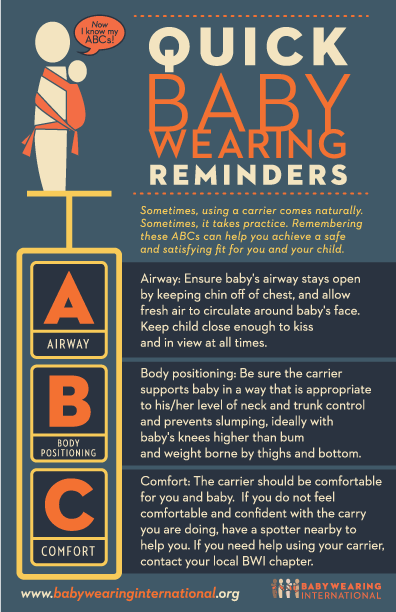

GUIDANCE AND SAFETY
For us, the most important aspect of our service is helping you ensure that your babywearing journey is a safe one. There are some simple rules that you should keep in mind at all times that will help you with this and if you ever have any queries it is worth referring back to these.
On this page we have provided copies of T.I.C.K.S. rules devised by the UK Sling Manufacturers and Retailers Consortium, and Babywearing International's Quick Reminders A.B.C. Both these guides highlight the importance of positioning and support to ensure that baby stays safe and comfortable.
We would add a few more to this:
In advance:
-
Get support and advice from more experienced babywearers or trained peer supporters.
-
Try different types of carriers before buying – you and your baby are unique, what fits a friend, may not suit you, or meet your needs.
-
Practice – lots! Practice at home; practice with friends; practice with partners, practice at a sling meet.
-
If trying a new or more complicated wrap: try it with a doll first; try it when you have someone else to support you; or try it somewhere safe, like over a bed.
-
Take advice on reliable brands – not all slings are created equally.
-
Buy from a reputable source - there are lots of fakes on the market (Ergo a particular problem in the UK).
-
Check new slings when they arrive – check stitching, seams, and whether they are a safe size for your child.
-
Seek advice if your child is premature or has any additional needs.
Using your sling:
-
Check your sling over – check stitching, seams, buckles, wear and tear – if in doubt, don't use.
-
Baby should be positioned high on the wearers body.
-
Aways adhere to manufacturer instructions and weight guidelines.
-
Check positioning regularly - Slings should mimic the way you carry your baby in your own arms;
-
Baby's face should be visible at all times;
-
Ensure baby has good support under their bottom (their seat);
-
Check on baby regularly, especially those under 6 months.
-
Hold on to baby when bending over, for extra support.
-
Use common sense – don't babywear in risky situations – ie in the car, up a ladder, whilst running.
-
Trust your instincts – if something feels or looks wrong – ask for advice.






